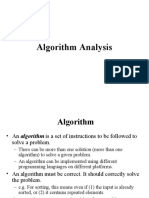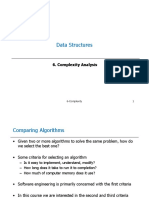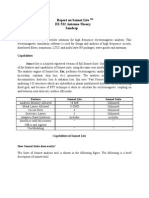COMP171
Fall 2005
Analysis of Algorithms
Review
Adapted from Notes of S. Sarkar of
UPenn, Skiena of Stony Brook, etc.
Introduction to Analysis of Algorithms / Slide 2
Outline
Why
Does Growth Rate Matter?
Properties of the Big-Oh Notation
Logarithmic Algorithms
Polynomial and Intractable Algorithms
Compare complexity
Introduction to Analysis of Algorithms / Slide 3
Why Does Growth Rate Matter?
Complexity
n
n2
n3
n5
2n
3n
10
20
0.00001 sec 0.00002 sec
0.0001 sec
0.0004 sec
0.001 sec
0.008 sec
0.1 sec
3.2 sec
0.001 sec
1.0 sec
0.59 sec
58 min
30
0.00003 sec
0.0009 sec
0.027 sec
24.3 sec
17.9 min
6.5 years
Introduction to Analysis of Algorithms / Slide 4
Why Does Growth Rate Matter?
Complexity
n
n2
n3
n5
2n
3n
40
50
60
0.00004 sec 0.00005 sec 0.00006 sec
0.016 sec
0.025 sec
0.036 sec
0.064 sec
0.125 sec
0.216 sec
1.7 min
5.2 min
13.0 min
12.7 days
35.7 years
366 cent
3855 cent 2 x 108 cent 1.3 x 1013 cent
Introduction to Analysis of Algorithms / Slide 5
Introduction to Analysis of Algorithms / Slide 6
Introduction to Analysis of Algorithms / Slide 7
Notations
Asymptotically less than or equal to
(Big-Oh)
Asymptotically greater than or equal to
(Big-Omega)
Asymptotically equal to
(Big-Theta)
Asymptotically strictly less
(Little-Oh)
Introduction to Analysis of Algorithms / Slide 8
Why is the big Oh a Big Deal?
Suppose
I find two algorithms, one of which
does twice as many operations in solving the
same problem. I could get the same job done
as fast with the slower algorithm if I buy a
machine which is twice as fast.
But if my algorithm is faster by a big Oh factor
- No matter how much faster you make the
machine running the slow algorithm the fastalgorithm, slow machine combination will
eventually beat the slow algorithm, fast
machine combination.
Introduction to Analysis of Algorithms / Slide 9
Properties of the Big-Oh Notation (I)
Constant
factors may be ignored:
For all k > 0, k*f is O(f ).
e.g. a*n2 and b*n2 are both O(n2)
Higher powers of n grow faster than lower powers:
nr is O(ns ) if 0 < r < s.
The growth rate of a sum of terms is the growth
rate of its fastest growing term:
If f is O(g), then f + g is O(g).
e.g. a*n3 + b*n2 is O(n3 ).
Introduction to Analysis of Algorithms / Slide 10
Properties of the Big-Oh Notation (II)
The growth rate of a polynomial is given by the
growth rate of its leading term
If f is a polynomial of degree d, then f is O(nd).
If f grows faster than g, which grows faster than
h, then f grows faster than h
The product of upper bounds of functions gives
an upper bound for the product of the functions
If f is O(g) and h is O(r), then f*h is O(g*r)
e.g. if f is O(n2) and g is O(log n), then f*g is
O(n2 log n).
Introduction to Analysis of Algorithms / Slide 11
Properties of the Big-Oh Notation (III)
Exponential
functions grow faster than
powers:
n k is O(b n ), for all b > 1, k > 0,
e.g. n 4 is O(2 n ) and n 4 is O(exp(n)).
Logarithms
grow more slowly than powers:
log b n is O(n k ) for all b > 1, k > 0
e.g. log 2 n is O(n 0:5 ).
All logarithms grow at the same rate:
log b n is (log d n) for all b, d > 1.
Introduction to Analysis of Algorithms / Slide 12
Properties of the Big-Oh Notation (IV)
sum of the first n rth powers grows as the
(r + 1) th power:
The
1 + 2 + 3 + . N = N(N+1)/2
(arithmetic series)
1 + 22 + 32 +N2 = N(N + 1)(2N + 1)/6
Introduction to Analysis of Algorithms / Slide 13
Logarithms
A
logarithm is an inverse exponential function
- Exponential functions grow distressingly fast
- Logarithm functions grow refreshingly show
Binary
search is an example of an O(logn)
algorithm
- Anything is halved on each iteration, then
you usually get O(logn)
If
you have an algorithm which runs in O(logn)
time, take it because it will be very fast
Introduction to Analysis of Algorithms / Slide 14
Properties of Logarithms
Asymptotically, the base of the log does not matter
log A B
log c B
log c A
log2n = (1/log1002) x log100n
1/log1002 = 6.643 is just a constant
Asymptotically, any polynomial function of n does not
matter
log(n475 + n2 + n + 96) = O(logn)
since n475 + n2 + n + 96 = O(n475) and
log(n475) = 475*logn
Introduction to Analysis of Algorithms / Slide 15
Binary Search
You have a sorted list of numbers
You need to search the list for the number
If the number exists find its position.
If the number does not exist you need to detect that
Introduction to Analysis of Algorithms / Slide 16
Binary Search with Recursion
// Searches an ordered array of integers using recursion
int bsearchr(const int data[], // input: array
int first,
// input: lower bound
int last,
// input: upper bound
int value
// input: value to find
)// output: index if found, otherwise return 1
int middle = (first + last) / 2;
if (data[middle] == value)
return middle;
else if (first >= last)
return -1;
else if (value < data[middle])
return bsearchr(data, first, middle-1, value);
else
return bsearchr(data, middle+1, last, value);
Introduction to Analysis of Algorithms / Slide 17
Complexity Analysis
T(n) = T(n/2) + c
O(?) complexity
Introduction to Analysis of Algorithms / Slide 18
Polynomial and Intractable Algorithms
Polynomial time complexity
An algorithm is said to have polynomial time
complexity iff it is O(nd) for some integer d.
Intractable Algorithms
A problem is said to be intractable if no
algorithm with polynomial time complexity is
known for it
Introduction to Analysis of Algorithms / Slide 19
Compare Complexity
Method
1:
A function f(n) is O(g(n)) if there exists a
number n0 and a nonnegative c such that for
all n n0 , f(n) cg(n).
Method 2:
If lim n f(n)/g(n) exists and is finite, then
f(n) is O(g(n))!
Introduction to Analysis of Algorithms / Slide 20
kf(n) is O(f(n)) for any positive constant k
kf(n) kf(n) , for all n, k > 0
f(n) is O(g(n)), g(n) is O(h(n)), Is f(n) O(h(n)) ?
f(n) cg(n) , for some c > 0, n m
g(n) dh(n) , for some d > 0, n p
f(n) (cd)h(n) , for some cd > 0, n max(p,m)
nr
is O(np)
if
r p since limn nr/np = 0, if r < p
= 1 if r = p
nr is O(exp(n)) for any r > 0
since limn nr /exp(n) = 0,
Introduction to Analysis of Algorithms / Slide 21
log n
is O (nr) if r 0,
Is kn O(n2) ?
since limnlog(n)/ nr = 0,
kn is O(n)
n is O(n2)
f(n) + g(n) is O(h(n)) if f(n), g(n) are O(h(n))
f(n) ch(n) , for some c > 0, n m
g(n) dh(n) , for some d > 0, n p
f(n) + g(n) ch(n) + dh(n) , n max(m,p)
(c+d)h(n) , c + d > 0, n max(m,p)
Introduction to Analysis of Algorithms / Slide 22
T1(n) is O(f(n)), T2(n) is O(g(n))
T1(n) T2(n) is O(f(n)g(n))
T1(n) cf(n) , for some c > 0, n m
T2(n) dg(n) , for some d > 0, n p
T1(n) T2(n) (cd)f(n)g(n) , for some cd > 0, n max(p,m)
T1(n) is O(f(n)), T2(n) is O(g(n))
T1(n) + T2(n) is O(max(f(n),g(n)))
Let h(n) = max(f(n),g(n)),
T1(n) is O(f(n)), f(n) is O(h(n)), so T1(n) is O(h(n)),
T2(n) is O(g(n)), g(n) is O(h(n) ), so T2(n) is O(h(n)),
Thus T1(n) + T2(n) is O(h(n))
Introduction to Analysis of Algorithms / Slide 23
Maximum Subsequence Problem
There is an array of N elements
Need to find i, j such that the sum of all elements between
the ith and jth position is maximum for all such sums
Algorithm 1:
Maxsum = 0;
For (i=0; i < N; i++)
For (j=i; j < N; j++)
{ Thissum = sum of all elements between ith and
jth positions;
Maxsum = max(Thissum, Maxsum);}
Introduction to Analysis of Algorithms / Slide 24
Analysis
Inner loop:
j=iN-1 (j-i + 1) = (N i + 1)(N-i)/2
Outer Loop:
i=0N-1 (N i + 1)(N-i)/2 = (N3 + 3N2 + 2N)/6
Overall: O(N^3 )
Introduction to Analysis of Algorithms / Slide 25
Algorithm 2
Maxsum = 0;
For (i=0; i < N; i++)
For (Thissum=0;j=i; j < N; j++)
{ Thissum = Thissum + A[j];
Maxsum = max(Thissum, Maxsum);}
Complexity?
i=0N-1 (N-i) = N2 N(N+1)/2 = (N2 N)/2
O(N2 )
Introduction to Analysis of Algorithms / Slide 26
Algorithm 3: Divide and Conquer
Step 1: Break a big problem into two small sub-problems
Step 2: Solve each of them efficiently.
Step 3: Combine the sub solutions
Introduction to Analysis of Algorithms / Slide 27
Maximum subsequence sum by
divide and conquer
Step 1: Divide the array into two parts: left part,
right part
Max. subsequence lies completely in left, or
completely in right or spans the middle.
If it spans the middle, then it includes the max
subsequence in the left ending at the center and the max
subsequence in the right starting from the center!
Introduction to Analysis of Algorithms / Slide 28
Example: 8 numbers in a sequence,
4 3
5 2
-1
2 6 -2
Max subsequence sum for first half =6 (4, -3, 5)
second half =8 (2, 6)
Max subsequence sum for first half ending at the last element is
4 (4, -3, 5, -2)
Max subsequence sum for sum second half starting at the first
element is 7 (-1, 2, 6)
Max subsequence sum spanning the middle is 11?
Max subsequence spans the middle 4, -3, 5, -2, -1, 2, 6
Introduction to Analysis of Algorithms / Slide 29
Maxsubsum(A[], left, right)
{
if left = right, maxsum = max(A[left], 0);
Center = (left + right)/2
maxleftsum = Maxsubsum(A[],left, center);
maxrightsum = Maxsubsum(A[],center+1,right);
maxleftbordersum = 0;
leftbordersum = 0;
for (i=center; i>=left; i--)
leftbordersum+=A[i];
Maxleftbordersum=max(maxleftbordersum,
leftbordersum);
Introduction to Analysis of Algorithms / Slide 30
Find maxrightbordersum..
return(max(maxleftsum, maxrightsum,
maxrightbordersum + maxleftbordersum);
Introduction to Analysis of Algorithms / Slide 31
Complexity Analysis
T(1)=1
T(n) = 2T(n/2) + cn
= 2(2T(n/4)+cn/2)+cn=2^2T(n/2^2)+2cn
=2^2(2T(n/2^3)+cn/2^2)+2cn = 2^3T(n/2^3)+3cn
= = (2^k)T(n/2^k) + k*cn
(let n=2^k, then k=log n)
T(n)= n*T(1)+k*cn = n*1+c*n*log n = O(n log n)
Introduction to Analysis of Algorithms / Slide 32
Algorithm 4
Maxsum = 0; Thissum = 0;
For (j=0; j<N; j++)
{
Thissum = Thissum + A[j];
If (Thissum 0), Thissum = 0;
If (Maxsum Thissum),
Maxsum = Thissum;
}
O(?)























































































